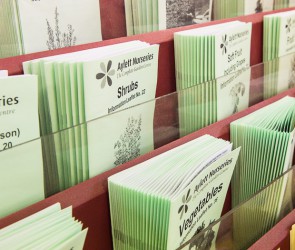- Home
- About
- Visiting Us
- AylettPlus
- Online Shop
- Our Range
- Plant Finder
- Seasons Café
- Events
- News
- Sustainability
- Contact Us
The Aylett Recipe For Best Results…
Dahlias grow best in a water-retentive soil but one that drains freely. They flower prolifically when planted in a sunny site sheltered from strong winds. The soil preparation should begin during the winter with plenty of organic matter being dug into the soil. Ideally the following spring at about 3-4 weeks before planting a slow acting fertilizer such as Bonemeal should be forked into the soil.
Spacing
Dahlias require plenty of room to develop, ideally 60cm-90cm 2ft -3ft) between plants, the larger the flower the larger the space. The Bedding Dahlias require less space and can be planted as close as 22cm-30cm (9-12ins) these then can be grown without staking although if the site is prone to winds they will benefit from short canes between the plants.
Planting Out
Dahlias should not be planted out until all fear of frosts is past; normally this is the end of May beginning of June. All sites differ and its best to keep an ear to your local forecasts, often a covering of frost protection material is all it needs to prevent your plants from being damaged.
Before planting water the young plants well. Plant in a good quality compost, firstly, because it retains moisture to help plant growth, and secondly, when the tuber is lifted in autumn, compost falls away, leaving a clean tuber. Make a hole 20cm square and 20cms deep and put in half a bucket of compost, and insert a strong cane or stake in the hole.
Remove the plant from the pot taking care not to disturb the root ball. With a hand trowel, place the plant next to the stake and firm in well. Plant so that the final soil level is just below the lowest leaves – and water in. Remember to label each plant.
Tying up immediately after planting is a good idea and will protect the young plants from strong winds that might cause damage. As soon as the plants start to grow a high Nitrogen feed such as Fish, Blood and Bone should be applied around each plant. Take great care not to scorch the plants.
Young plants can also attract slugs so a few slug pellets scattered around the plants is advisable, not forgetting to use the bird friendly ones.
Stopping
‘Stopping’ is the removal of the growing tip when about four pairs of leaves have been formed. Nip out the tip just above the third pair of leaves, but avoid squashing the stem.
Strong side shoots will develop at the leaf joints, to form the framework of the plant. Plants have often been stopped by us before you purchase so as to produce a stronger plant. If you are planning to exhibit and like to regulate your stopping times, unstopped plants are usually available.
Growing on and Feeding
Early in the season weeds should be kept at bay by shallow hoeing this will also keep the soil surface open. By August apply a mulch of suitable material such as garden compost or straw. Be sure to water during hot dry conditions, preferably in the evening.
Depending on the richness of the soil, feeding with a liquid feed every 14 days can be advantageous. From August onwards a high potash fertilizer is recommended, such as Tomato feed, this will help with flower colour, stem strength, root growth and tuber formation.
Dahlias suffer from the usual garden pests, Earwigs being the one most closely associated with the genus. We here at St Albans never find this to be a great problem but a spraying programme carried out on a regular basis will prevent an outbreak of undesirable pests. Massed borders in parks and gardens produce magnificent displays without the use of pesticides just leaving Mother Nature to her own devices. If you must spray do so in the evening when the bees have finished their work for the day. Towards the end of the season especially if it has been hot and dry Dahlias can be infected with mildew This takes the form of a white powdery covering on the leaves and stems, to combat this disease spray every two weeks with Fungus Fighter.
Always read the label ! When using Pesticides and Fertilisers always follow the manufacturer’s instructions.
For a good garden display disbudding is not always necessary. As each terminal bud flowers and becomes past its best, carefully remove it to allow the side shoots to develop All old flowers should be removed to encourage further side buds to develop and flower.
Lifting and Storing of Tubers
Dahlia tubers should not be lifted until after a frost. They should be cut down to 6ins from soil level and carefully dug up. Take care not to damage the crown as it is from this point that next year’s shoots emerge.
Tubers should be dried and it is advisable to stand them upside down in order to allow moisture in the stems to drain away. They should be dusted with yellow sulphur and put in wooden boxes, packed with dry peat, vermiculite, straw or even newspaper to stop them drying out. Keep in a frost-free place. Most garden sheds and garages are not frost proof. They should not be kept in too warm a place as they will shrivel or a cold damp situation where they will rot. It is advisable to examine tubers several times in the winter and if any trace of rot is found the infected part should be cut away and the wound dusted with yellow sulphur.






